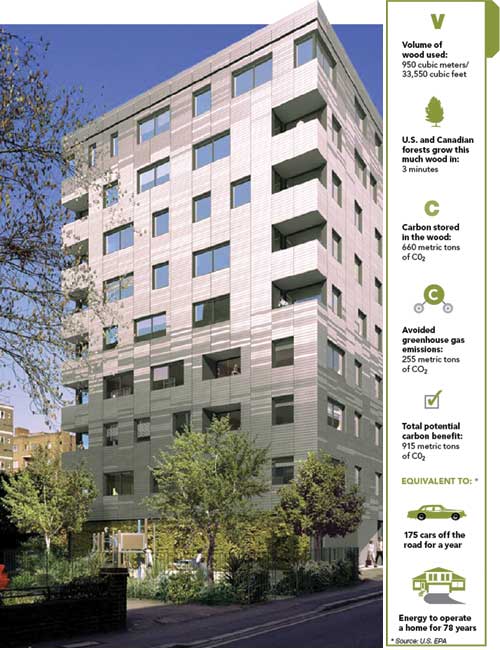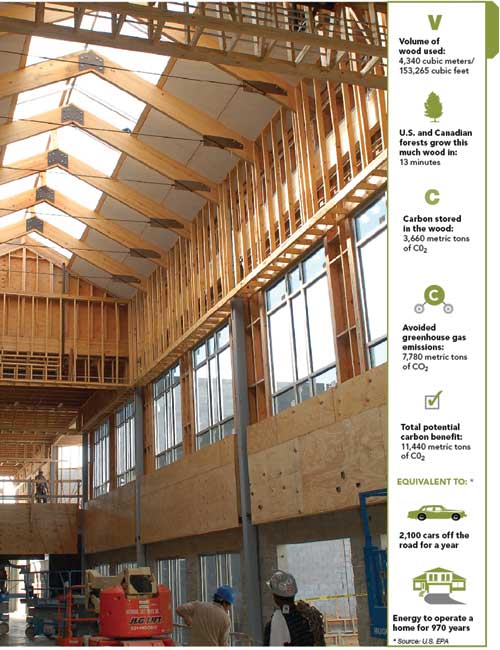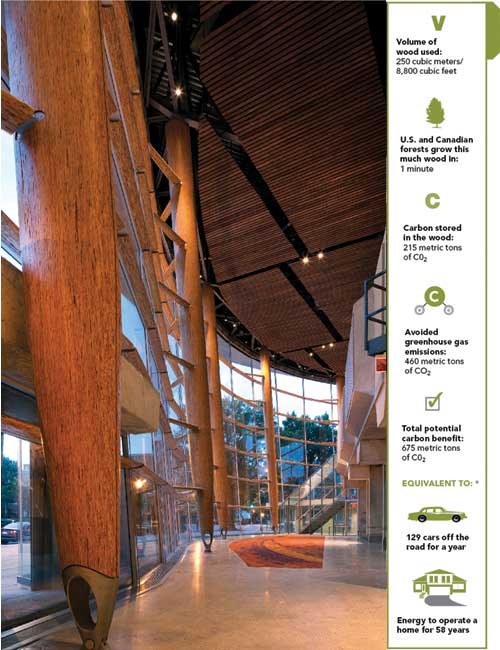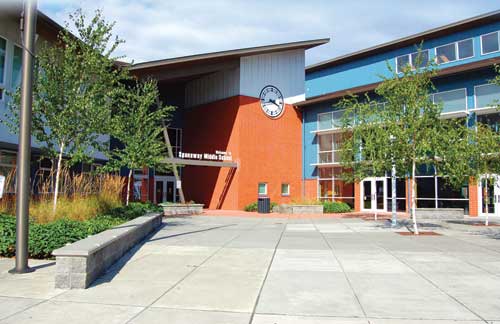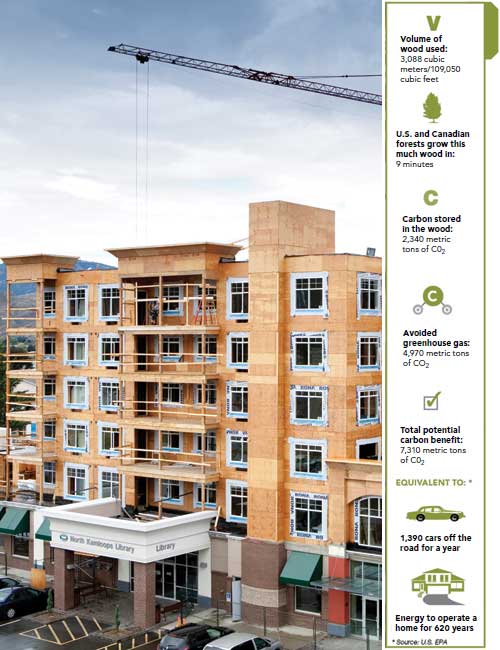Calculating Carbon Footprint
The life cycle benefits of wood buildings
![]() Continuing Education
Continuing Education
Use the following learning objectives to focus your study while reading this month’s Continuing Education article.
Learning Objectives - After reading this article, you will be able to:
- Discuss the role of wood products sourced from sustainably managed forests in the design of sustainable, environmentally positive buildings.
- Compare the carbon benefits of example buildings based on the results of two calculators.
- Examine the natural cycle of carbon absorption and storage, and the role of forests and wood products in mitigating carbon emissions.
- Explain the low embodied energy of wood products, and how this translates into avoided carbon emissions throughout their life cycles.
Worldwide, there has been increasing focus on the carbon footprint of buildings and recognition that design professionals are uniquely positioned to reduce greenhouse gases in the atmosphere by creating high-performance structures. Energy efficiency, once the new frontier for environmentally conscious designers, is now a commonplace objective and net zero energy is well within reach. As a result, greater attention is now being focused on the materials used to construct buildings—and the benefits, carbon and otherwise, of using wood from sustainably managed forests instead of products that are fossil fuel-intensive.
Extensive research, some of it developed in countries where ambitious government policies promoting carbon efficiency are being implemented, and sophisticated new calculation tools are making it possible for architects to evaluate and compare the impacts of different materials on the carbon footprint of buildings. Similarly, there is an increasing number of life cycle assessment (LCA) tools that allow designers to evaluate and compare buildings based on a range of indicators such as air pollution, water pollution, and waste.
This course examines the environmental impacts of wood products—from the global scale of the world's forests to the individual scale of efficient, adaptable, and innovative buildings—using real-world examples from two U.S. carbon calculators as well as the latest research on LCA.
Calculating Carbon Footprint
Much of the information available about the effectiveness of wood products in reducing a building's carbon footprint has been driven by an increasing focus on carbon elsewhere in the world. The European Union, for example, is seeking to reduce carbon emissions by having all new commercial buildings achieve net zero energy by 2020. Similarly, the French government legislated measures that aim to increase the building sector's use of timber and resulting carbon benefits. The UK has also established new policies in an ambitious shift to a low-carbon economy.
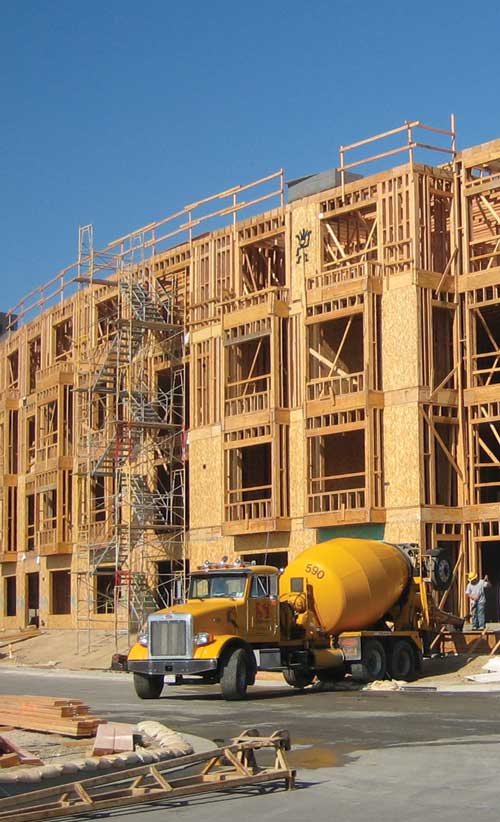 |
This mid-rise building in Irvine, California, is reaping the carbon benefits of using wood. Photo by VanDorpe Chou Associates |
In the U.S., increasing emphasis on the effects of carbon in the atmosphere has motivated the development of many calculators for various products and activities. The two calculators used in this course can help U.S. architects understand and compare the carbon impacts of their building designs.
Project: Stadthaus The Stadthaus includes eight stories of cross laminated timber (CLT) over one story of concrete. Detailed estimates presented at the concept stage indicated that building the structure in wood would cost approximately 15 percent less than the same structure in concrete. |
Developed by the U.S. Environmental Protection Agency, the Greenhouse Gas Equivalencies Calculator1 translates emissions data into recognizable equivalents such as annual greenhouse gas emissions from passenger vehicles or CO2 emissions from the energy used to operate a home for a year. The second tool2 was developed to allow users to calculate the carbon benefits of wood buildings, including the amount of carbon stored in the wood products, emissions avoided by not using steel or concrete, and amount of time it takes North American forests to grow that volume of wood. It does this in one of two ways:
- If the volume of wood products is known (including lumber, panels, engineered wood, decking, siding, and roofing), the carbon calculator will provide a detailed estimate for that specific building. The more detailed the information, the better the results.
- If volume information is unknown, users can select from a list of common building types and receive an estimate based on typical wood use.
For the more detailed calculation, users enter the nominal volume of wood in a building, and the calculator then performs necessary volume conversions, makes corrections for moisture content, and arrives at a total mass figure of wood contained in the building. The tool then uses that information to estimate the building's carbon benefits.
Both the Greenhouse Gas Equivalencies Calculator and the carbon calculator were used to generate the equivalencies in this course. In the Stadthaus project shown at left, the calculators estimated significant carbon benefits from the volume of wood used.
In addition, the building was projected to weigh four times less than its concrete counterpart, which lowered transportation costs, allowed the design team to reduce the foundation by 70 percent, and eliminated the need for a tower crane during construction. Particularly impressive to the developers was the fact that the architect proposed to shave five months off the typical construction process for this type of building—a goal he managed to exceed.
Forests Absorb, Store, and Release Carbon
Responsibly managing forests in a way that balances harvesting and replanting, and provides a sustainable source of wood products that continue to store carbon and offset the use of fossil fuels, can significantly reduce the amount of carbon in the atmosphere over the long term.
As trees grow, they clean the air we breathe by absorbing carbon dioxide (CO2) from the atmosphere. They release the oxygen (O2) and incorporate the carbon (C) into their twigs, stems, roots, leaves or needles, and surrounding soil. Young, vigorously growing trees absorb the most carbon dioxide, with the rate slowing as they reach maturity (typically 60-100 years, depending on species and environmental factors). A single tree can absorb more than 10 pounds of CO2 each year.3
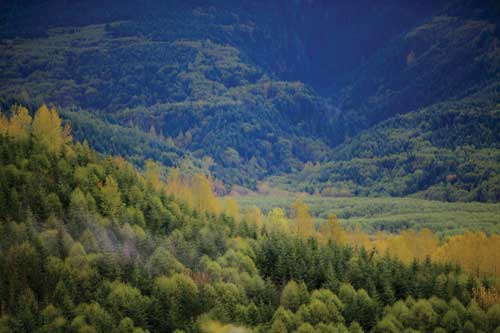 |
Active forest management helps to ensure that forests store more carbon than they release. Photo by Weyerhaeuser Company |
As trees mature and then die, they start to decay and slowly release the stored carbon back into the atmosphere. Carbon is also released, but more quickly, when forests succumb to natural hazards such as wildfire, insects or disease.
Growing forests absorb, store, and release carbon over extended periods of time. Forests in the U.S. and Canada have sequestered high levels of carbon in recent decades. In both countries, net forest growth has exceeded annual forest harvests for more than 50 consecutive years.4 According to the National Report on Sustainable Forests – 2010,5 “Total U.S. forest area, as defined for the purposes of this report, currently amounts to 751 million acres, or about one-third of the nation's total land area. Since the beginning of the past century, the size of this inventory has been relatively stable, and the forests it represents remain largely intact...” In the U.S., forests and forest products store enough carbon each year to offset approximately 10 percent of the nation's total CO2 emissions.6
That said, changing environmental conditions have made the active management of forests critical. For example, wildfire is a natural and inherent part of the forest cycle. Today, however, wildfires must be prevented from burning unchecked because of danger to human life and property. As a result, many forests have become over-mature and overly dense with excess debris, which, combined with more extreme weather, has caused an increase in both the number and severity of wildfires. The combination of older forests and changing climate is also having an impact on insects and disease, causing unprecedented outbreaks such as the mountain pine beetle—which further add to the fire risk.
Active forest management, which includes thinning overly dense forests to reduce the severity of wildfires, helps to ensure that forests store more carbon than they release. Forest management activities aimed at accelerating forest growth also have the potential to increase the amount of carbon absorbed from the atmosphere, since young trees capture the largest amounts of carbon. The International Panel on Climate Change (IPCC) has stated: “In the long term, a sustainable forest management strategy aimed at maintaining or increasing forest carbon stocks, while producing an annual sustained yield of timber, fibre or energy from the forest, will generate the largest sustained mitigation benefit.”7
Whether trees are harvested and used for products or decay naturally, the cycle is ongoing, as forests regenerate and young trees once again begin absorbing carbon. But when trees are manufactured into products and used in buildings, a new phase of carbon mitigation begins.
Wood Buildings Store Carbon
Wood is comprised of about 50 percent carbon by dry weight.8 So the wood in a building is providing physical storage of carbon that would otherwise be emitted back into the atmosphere. For example, according to research organization FPInnovations, a 2,400-square-foot home with about 32 cubic meters of structural wood products is storing the equivalent of about 29 metric tons of carbon.
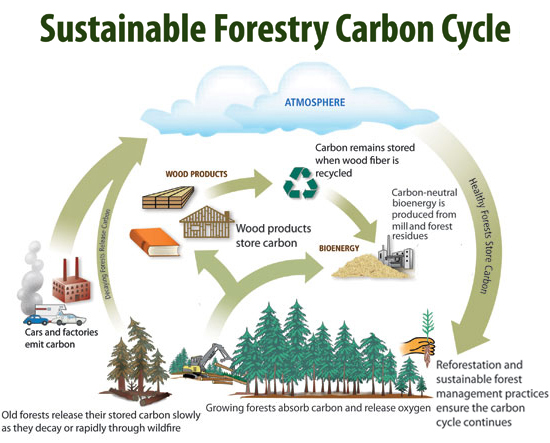 |
|
Source: Tackle Climate Change—Use Wood |
In a wood building, the carbon is kept out of the atmosphere for the lifetime of the structure—or longer if the wood is reclaimed and reused or manufactured into other products. Wood stores more carbon than is emitted during its harvest, production, transport, and installation—even when transported over great distances.
In 2008, the amount of carbon stored in U.S. wood products (including those in landfill sites) was estimated at 3.5 billion metric tons—but the cumulative impact over time is much greater. The accumulation of stored carbon is about 60 million metric tons each year. Most of this resides in the nation's housing stock, 90 percent of which is wood-frame construction. Assuming that a greater number of homes and non-residential wood buildings are built each year than deconstructed, the amount of stored carbon can be expected to grow significantly.9 Put another way, continuously increasing the amount of carbon stored in U.S. buildings will provide significant mitigation of carbon emissions.
Wood Has Low Embodied Impacts
Embodied energy—which is the energy required to harvest, manufacture, transport, install, maintain, and dispose or recycle a material—also contributes to wood's light carbon footprint. Life cycle assessment (LCA) studies, which consider the environmental impacts of materials over their entire lives, consistently show that wood performs better than other materials in terms of embodied energy, air and water pollution, and greenhouse gas emissions.
One of the reasons wood performs well is that it requires far less energy to manufacture than other materials10—and very little fossil fuel energy, since most of the energy used comes from converting residual bark and sawdust to electrical and thermal energy. For example, the production of steel, cement, and glass requires temperatures of up to 3,500°F, which is achieved with large amounts of fossil fuel energy. On average, the U.S. and Canadian forest industries generate about 65 percent and 60 percent of their energy needs (respectively) from sources other than fossil fuels.
A comprehensive review of scientific literature examined research done in Europe, North America, and Australia pertaining to life cycle assessment of wood products.11 It applied life cycle assessment criteria in accordance with ISO 14040-42 and concluded, among other things, that:
- Fossil fuel consumption, potential contributions to the greenhouse effect, and the quantities of solid waste tend to be minor for wood products compared to competing products.
- Wood products that have been installed and are used in an appropriate way tend to have a favorable environmental profile compared to functionally equivalent products made out of other materials.
Increasingly, architects and engineers are utilizing LCA as an objective way to compare the environmental impacts of their material choices. The number of LCA databases for building materials and products, and tools for calculating their impact, is growing. For example, the Consortium for Research on Renewable Industrial Materials (CORRIM) undertakes LCA research, concentrating on U.S. products and materials.
In 2005 and 2010, CORRIM published the results of two phases of a landmark study comparing wood-frame and steel-frame homes in Minneapolis and wood-frame and concrete homes in Atlanta (the building types most common in those parts of the country). Phase II placed an emphasis on carbon footprint, and confirmed that the carbon stored in wood products offsets many of the emissions from other products. Despite the small total mass difference resulting from substituting steel or concrete framing for wood, the Global Warming Potential (CO2 equivalent of greenhouse gas emissions, including CO2, methane, and nitrous oxide) from the steel-framed house was 26 percent greater than the house with wood walls and floors, without considering the carbon stored in the wood products. This became a 120 percent difference when the carbon stored in the wood products for the life of the house was included. Emissions from the completed, concrete wall-framed house were 31 percent greater than the wood wall house without considering the carbon stored in wood products, and 156 percent greater when these carbon stores were included in the calculation.
 |
|
Source: Utilization of Harvested Wood by the North American Forest Products Industry, Dovetail Partners, Inc. |
The Athena Sustainable Materials Institute undertakes similar research and also develops and maintains LCA tools for use by North American building designers. The Athena Impact Estimator for Buildings is a robust, easy-to-use software tool for evaluating the environmental footprint of whole buildings and building assemblies. The Athena EcoCalculator is a simplified version with pre-calculated assemblies in a spreadsheet format. Both tools use internationally recognized LCA methods in the background. The EcoCalculator is available free from the Athena Sustainable Materials Institute.
Project: El Dorado High School El Dorado High School was one of the first schools in Arkansas to make extensive use of wood following a 2009 change in policy that had prohibited wood in school construction. The school was originally designed in steel and masonry, but came in over budget. By switching to wood framing, the project team saved $2.7 million.12 |
Wood: Solid Enough for Scrutiny
As the choice of building materials receives more scrutiny, and life cycle costs are more precisely analyzed, wood's environmental benefits throughout its use and re-use in buildings are being extensively documented.
Low-Waste Manufacturing
On average, North American wood producers use 99 percent of every tree brought to the mill for processing. According to a report from Dovetail Partners, Inc., the term “waste” is largely obsolete in the context of today's North American forest products industry, as logs brought to U.S. and Canadian sawmills and other wood product manufacturing centers are converted almost totally to useful products. The sector has been making strides since the 1930s and, in terms of fiber utilization, has become a zero-waste industry.13 (See timber utilization graphic on the previous page.)
Project: Arena Stage at the Mead Center for American Theater Arena Stage is the first modern building of its size to use heavy timber components in the United States capital. It was also the first project in the U.S. to use a hybrid wood and glass enclosure to envelop two existing structures. |
Low-Waste Design and Construction
Wood offers numerous opportunities for design and building professionals to reduce waste through design optimization, specification of recovered wood, and use of pre-sized framing members, or of pre-manufactured and engineered components. In many cases, clean job site waste can also be separated and taken to local recovery centers.
Adaptability and Service Life
The fact that wood buildings are easily adapted or dismantled and re-used adds to their environmental benefits. Although there are examples of wood-frame buildings that remain structurally sound after hundreds of years, North American buildings often have a service life of less than 50 years, regardless of material, because of changing needs or increasing land values.14 When one considers the embodied energy in these structures and the implications of material disposal, it is easy to understand why one of the tenets of sustainable design is that buildings should last 100 years or more. Partly this is a call for more durable materials, but another important factor in building sustainability is the use of building systems that can adapt to changing needs, either through renovation or deconstruction and re-use.
Toward Net Zero Energy
Wood has low thermal conductivity compared to steel and concrete. But since there are many factors that have a greater influence on a building's energy efficiency, the more relevant point for many designers is that wood building systems lend themselves to structures that are highly energy efficient (see sidebar: Saving Energy with Wood-frame Construction).
New wood building systems have also been developed that offer greater air tightness, less conductivity, and more thermal mass, including prefabricated systems that contribute to the low energy requirements of Passive House and net-zero designs. Passive House is an approach that uses the building's architecture to leverage natural energy sources, minimize energy consumption, and improve thermal comfort. Popular in Europe and gaining ground in North America, passive buildings rely heavily on high-performing building envelope assemblies and passive solar energy. Wood is an attractive material for passive design because of how it combines thermal mass with a number of performance merits, including water resistance, structural integrity, and finish quality. Although there are several types of net-zero-energy buildings, the term generally refers to residential or commercial buildings that are extremely energy efficient and produce the small amount of energy they do need via on-site renewable sources. Buildings may draw energy from the grid at night and return energy generated from renewable sources back to the grid during the day. The U.S. Department of Environment has a goal that all new commercial buildings be net zero energy by 2025.
| Saving Energy with Wood-frame Construction | ||
Between 2004 and 2011, the Bethel School District (BSD) reduced energy usage by more than 7.6 million kilowatts and saved $4.3 million in utility costs—equivalent to the cost of electricity for 15 of the District’s elementary schools for one year. BSD reports an 81 percent ENERGY STAR rating overall, and several of their 17 elementary and six junior high schools have a rating of between 95 and 98 percent. While size, configuration and age of the 23 facilities varies, one thing is constant: each is wood-frame. According to the BSD Director of Construction and Planning, Jim Hansen, wood framing allows them to over-insulate with inexpensive batt insulation, increasing energy efficiency. Wood framing also offers a number of thermal benefits. “Steel and concrete need separation between the structure and exterior envelope,” said architect Wayne Lerch. “This separation is not required with wood because of its inherent thermal properties.” In the past, the building code did not distinguish between wood and metal or concrete when it came to exterior walls and thermal breaks. However, the 2009 Washington State Energy Code requires a thermal break between exterior and interior walls for metal and concrete, which means thicker walls and added cost. Wood doesn’t have this requirement, so the exterior skin can be directly attached to the wood stud. |
Project: Library Square Library Square is a six-story mixed-use development that includes five stories of wood-frame housing over a 20,500-square-foot library and 15,000 square feet of retail space. |
Wood for a Sustainable Future
“Increasing the global forest land base and increasing the capacity of each forest, while using them as a sustainable supply of wood for building materials and fuel to offset the need for other energy-intensive materials and fossil fuels represents an important carbon mitigation option over the long term.”
—UN Food and Agriculture Organization, 2010 report
Perhaps it is not surprising that wood, one of the oldest and most natural building materials on earth, would have a more positive environmental impact than materials that are highly energy intensive. But only recently has the analysis of products used in buildings become sophisticated enough to study and measure that impact scientifically. Actively managed forests store large amounts of atmospheric carbon. Wood products are manufactured from the renewable, natural raw material that results from the forest cycle. They are adaptable and reusable, and they continue to store carbon throughout their lifetimes. These characteristics make wood an excellent, low-carbon alternative to many of the materials now widely used in construction and consumer goods. Just as wood has been a desirable building material since the distant past, it will make an essential contribution to a sustainable future.
Project: New Earth Market This 20,000-square-foot market includes a hybrid panelized roof system that offered the benefit of wood’s lower cost while integrating exposed steel to achieve the modern industrial look the client wanted. |
NOTE:
The carbon calculations throughout this CEU were estimated using the Wood Carbon Calculator for Buildings [www.woodworks.org], based on research by Sarthre, R. and J. O’Connor, 2010, A Synthesis of Research on Wood Products and Greenhouse Gas Impacts, FPInnovations. Note: CO2 on these charts refers to CO2 equivalent.
| ENDNOTES | |
| 1 | http://www.epa.gov/cleanenergy/energy-resources/calculator.html |
| 2 | http://woodworks.org/design-tools/online-calculators/ |
| 3 | American Forest & Paper Association, http://www.afandpa.org/our-industry/fun-facts |
| 4 | Calculated by Dovetail Partners Inc., based on data from Natural Resources Canada and the USDA Forest Service |
| 5 | USDA Forest Service, http://www.fs.fed.us/research/sustain/national-report.php |
| 6 | American Forest & Paper Association, http://www.afandpa.org/our-industry/fun-facts |
| 7 | Impact of the global forest industry on atmospheric greenhouse gases, Food and Agriculture Organization of the United Nations, 2010, http://www.fao.org/docrep/012/i1580e/i1580e00.pdf |
| 8 | A Synthesis of Research on Wood Products and Greenhouse Gas Impacts, FPInnovations, 2010, http://www.forintek.ca/public/pdf/Public_Information/technical_rpt/TR19%20Complete%20Pub-web.pdf |
| 9 | Dovetail Partners, Inc., http://www.dovetailinc.org/files/DovetailCarbon0408hz.pdf |
| 10 | A Synthesis of Research on Wood Products and Greenhouse Gas Impacts, FPInnovations, 2010 |
| 11 | Werner, F. and Richter, K., 2007, Wooden building products in comparative LCA: A literature review; International Journal of Life Cycle Assessment, 12(7):470-479 |
| 12 | El Dorado High School case study, U.S. WoodWorks, http://woodworks.org/publications/case-studies-design-examples/ |
| 13 | Utilization of Harvested Wood by the North American Forest Products Industry, Dovetail Partners Inc., http://www.dovetailinc.org/reportsview/2012/sustainable-forestry/pjim-bowyerp/utilization-harvested-wood-north-american-forest-%20 |
| 14 | Survey on actual service lives for North American buildings, O’Connor, J., FPInnovations |
 |
The reThink Wood initiative is a coalition of interests representing North America's wood products industry and related stakeholders. The initiative shares a passion for wood and the forests they come from. Innovative new technologies and building systems have enabled longer wood spans, taller walls, and higher buildings, and continue to expand the possibilities for wood use in construction. www.rethinkwood.com |

